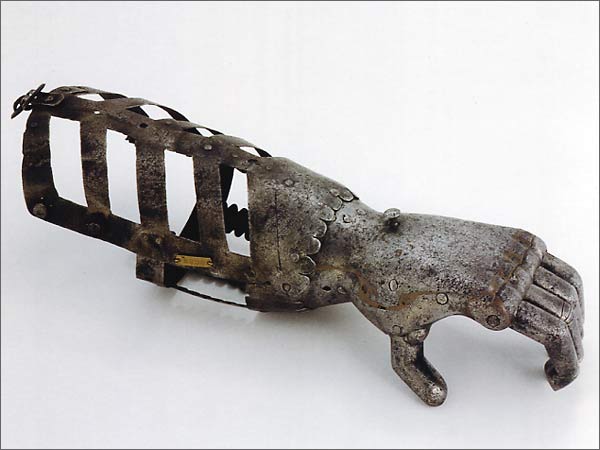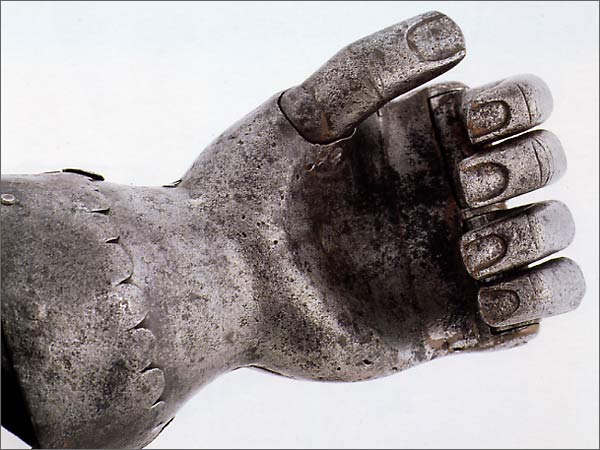Steam-punk's got nothing on this...
A Rare German Prosthetic Hand, circa 1580
Made entirety of iron, with a hollow, naturally modeled hand furnished with a movable thumb and paired fingers, internal ratchet mechanism and external push-button release, and a tubular socket comprising of a long outer plate fretted with a pattern of repealed chevrons, and short inner section formed of plain and scalloped riveted strips, each fitted with buckles for the attachment of a harness.
Overall length: 12 1/2 in; Weight: 1 lb

It is not unlikely that armourers, with their proven skills in working and articulating metal to the forms of the human body, would have been among the first craftsmen to involve themselves in the manufacture of functional artificial limbs. In the case of the hand shown here, both the thumb and the paired fingers are capable of being independently locked in several positions by means of an elaborate system of ratchets and spring-operated pawls that can be instantly released by pressure on a push-button protruding from the back of the hand.
The earliest surviving hands of this kind are those made for the celebrated Franconian Knight, Götz von Berlich (circa 1480-1562), raised to heroic status by the young Goethe in his childrens' drama of 1772. Two are preserved in Schloss Jagsthausen, and a third in Schloss Grüningen bei Riedlingen. They were clearly made after 22 June 1504 when the twenty-four year old Götz lost his right hand to a cannon ball at the siege of Landshuf, but probably no later than 1512 when a prisoner of the Nuremberg campaign recorded that er hab auch Gotzen von Berlingen mit de rein hend aigentlich gesehen, hab an der eysinen hand ein handschuch gehapt (he personally saw Gotzen von Berlingen with the one hand, having had a glove on his iron hand). With his 'iron hand' Götz distinguished himself in a long active military career. According to a verse composed by Count Franz Pocci in 1861, it allowed him to securely grip both his lance and his sword. The earlier of the two Jagsthausen hands is constructionally very similar to the present example.

All three of the hands of Götz von Berlich, however, have a somewhat angular form, reflecting their early date. The present example, with its more carefully modeled hand, can be compared with one recovered from the grave of die Knight Hans von Mittelhausen of Balbronn, Alsace, who died in 1564, as well as another in the Hessisches Landesmuseum, Darmstadt, which is said to have belonged to a Swedish officer who fell in the Thirty Years War (1618-48). Other examples of this mid-16th to early I7th century type can be recorded in the Museum Otto Ludwig, Eisenfeld, Thuringia, the Bayerisches Armeemuseum, Ingolstadt, the Livruskammaren, Stockholm, Schloss Skokloster, Sweden, the Museo Poldi Pezzoli, Milan, the Fitzwilliam Museum, Cambridge, and the Welcome Medical Collection in the Science Museum, London.
Provenance: F.W. Paul Collection, Berlin
Text and Images are copyright 2004 by Peter Finer, and were drawn to my attention by Nathan Robinson of www.myarmoury.com.
Made entirety of iron, with a hollow, naturally modeled hand furnished with a movable thumb and paired fingers, internal ratchet mechanism and external push-button release, and a tubular socket comprising of a long outer plate fretted with a pattern of repealed chevrons, and short inner section formed of plain and scalloped riveted strips, each fitted with buckles for the attachment of a harness.
Overall length: 12 1/2 in; Weight: 1 lb

It is not unlikely that armourers, with their proven skills in working and articulating metal to the forms of the human body, would have been among the first craftsmen to involve themselves in the manufacture of functional artificial limbs. In the case of the hand shown here, both the thumb and the paired fingers are capable of being independently locked in several positions by means of an elaborate system of ratchets and spring-operated pawls that can be instantly released by pressure on a push-button protruding from the back of the hand.
The earliest surviving hands of this kind are those made for the celebrated Franconian Knight, Götz von Berlich (circa 1480-1562), raised to heroic status by the young Goethe in his childrens' drama of 1772. Two are preserved in Schloss Jagsthausen, and a third in Schloss Grüningen bei Riedlingen. They were clearly made after 22 June 1504 when the twenty-four year old Götz lost his right hand to a cannon ball at the siege of Landshuf, but probably no later than 1512 when a prisoner of the Nuremberg campaign recorded that er hab auch Gotzen von Berlingen mit de rein hend aigentlich gesehen, hab an der eysinen hand ein handschuch gehapt (he personally saw Gotzen von Berlingen with the one hand, having had a glove on his iron hand). With his 'iron hand' Götz distinguished himself in a long active military career. According to a verse composed by Count Franz Pocci in 1861, it allowed him to securely grip both his lance and his sword. The earlier of the two Jagsthausen hands is constructionally very similar to the present example.

All three of the hands of Götz von Berlich, however, have a somewhat angular form, reflecting their early date. The present example, with its more carefully modeled hand, can be compared with one recovered from the grave of die Knight Hans von Mittelhausen of Balbronn, Alsace, who died in 1564, as well as another in the Hessisches Landesmuseum, Darmstadt, which is said to have belonged to a Swedish officer who fell in the Thirty Years War (1618-48). Other examples of this mid-16th to early I7th century type can be recorded in the Museum Otto Ludwig, Eisenfeld, Thuringia, the Bayerisches Armeemuseum, Ingolstadt, the Livruskammaren, Stockholm, Schloss Skokloster, Sweden, the Museo Poldi Pezzoli, Milan, the Fitzwilliam Museum, Cambridge, and the Welcome Medical Collection in the Science Museum, London.
Provenance: F.W. Paul Collection, Berlin
Text and Images are copyright 2004 by Peter Finer, and were drawn to my attention by Nathan Robinson of www.myarmoury.com.
Information about Götz von Berlichingen and his prothestic hand (pictured below) can be found through wikipedia, (here)




2 comments:
I found a couple of cutaway drawings here:
www.uihealthcare.com/depts/medmuseum/wallexhibits/body/histofpros/histofpros.html
Allow me to be juvenile: Metallic Masturbation.
Post a Comment